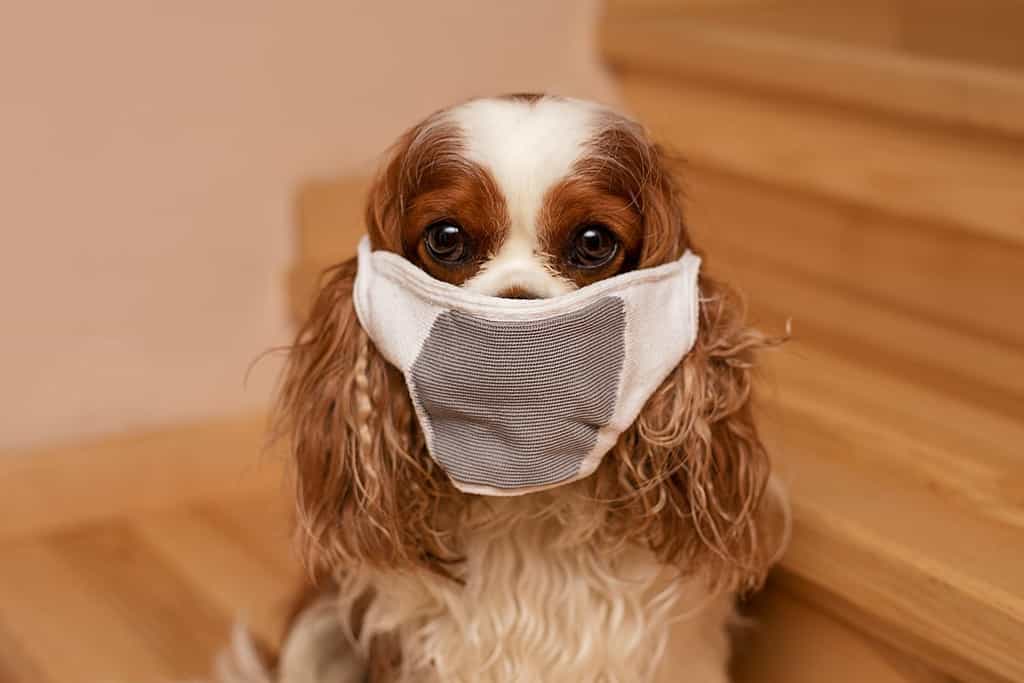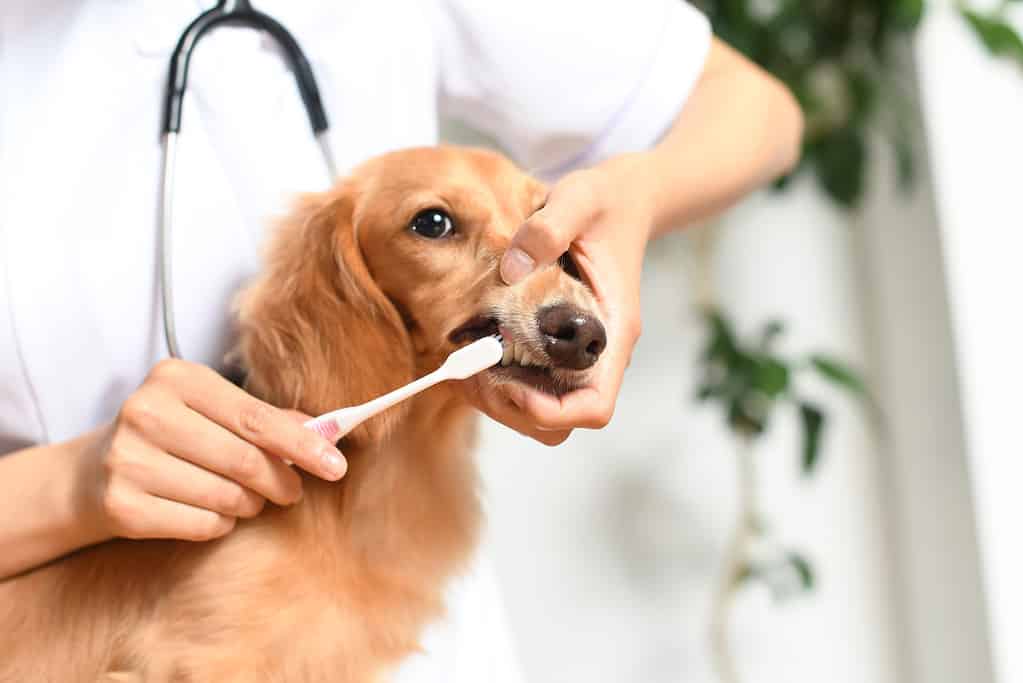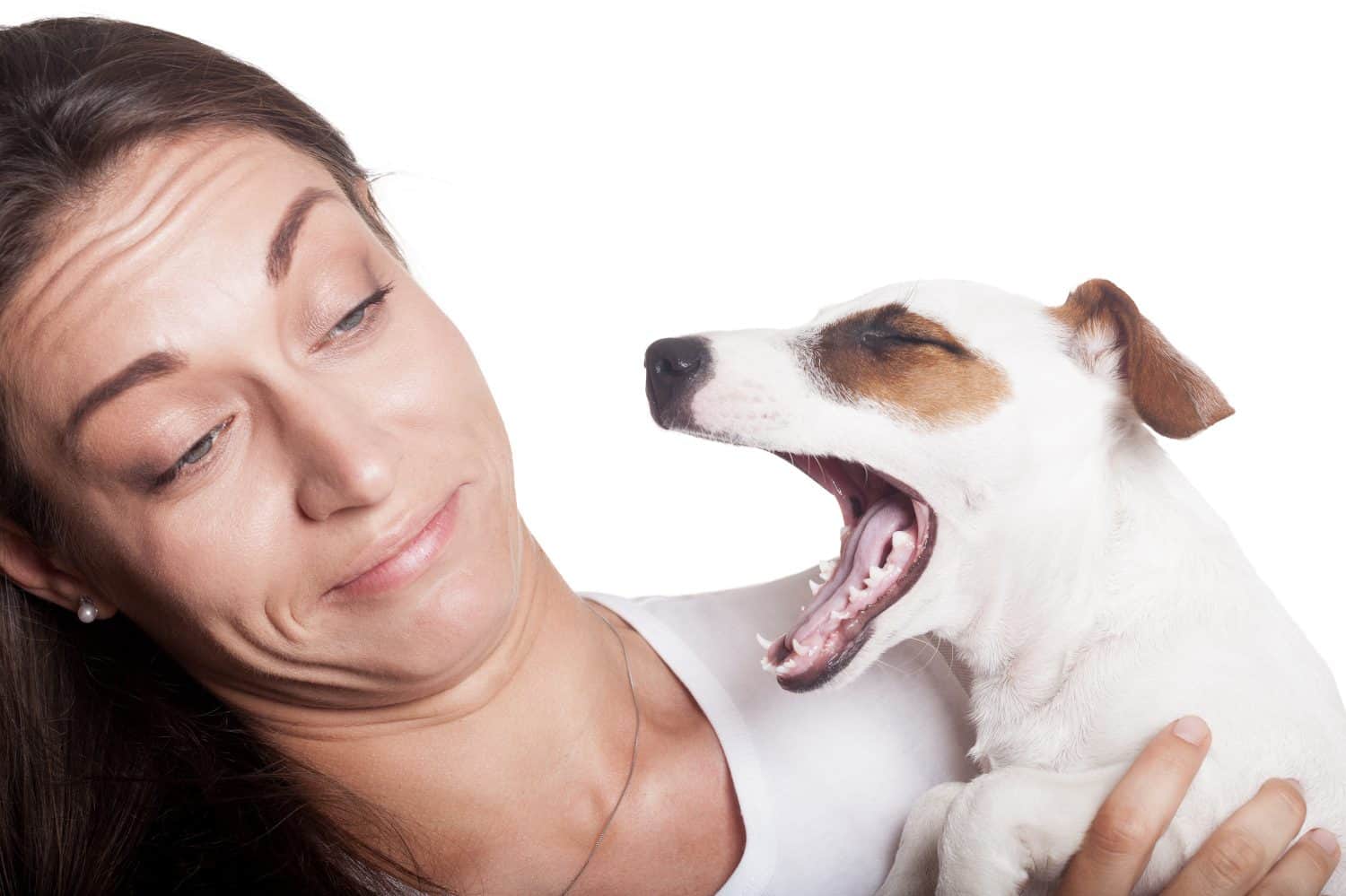
Dogs of any size can have bad breath due to improper dental hygiene and bacteria growing in the mouth.
©yamamedal/iStock via Getty Images
Small dog breeds are some of the fluffiest and most adorable dog breeds. They stay a “puppy size” for their entire life, develop strong bonds with their owners, and learn to act big and strong to protect their humans.
However, small dogs have a unique problem of developing bad breath faster than big dogs. Sometimes their breath gets so bad that owners can smell their foul breath from several feet away!
This article describes why small-dog breeds seem to get bad breath faster than larger dogs and methods pet parents should adopt to keep their puppy’s breath fresh and clean.
What Causes Bad Breath

Dogs should never pick up leaves because they could be covered in harmful chemicals like pesticides.
©Page Light Studios/iStock via Getty Images
Pets experience halitosis (bad breath) in the same way as people. Typically, poor dental hygiene and deteriorating food caught in the mouth will cause bad breath. Humans can manage it with mouthwash, mints, and other dental hygiene products, but pets will suffer from other causes with few solutions.
Alternative reasons for pets to experience bad breath are:
- Smelly Foods: Strong odors sticking to the dog’s mouth will cause every exhale to smell like the food they ate. It is common for small dogs to pick up strange objects like another dog’s poop because they find it tasty. When the dog devours poop, their breath will smell like poop.
- Dental Disease: The main cause of all dental problems, including bad breath, is periodontal disease. Decaying food matter sticks to the teeth, causing bacteria to form and release an unpleasant odor. Then, that odor is released with each breath. The severity of bad breath relates to the severity of plaque and tartar build-up.
- Gastrointestinal (GI) issues: Bacteria are needed to help the body break down food into vital nutrients for fuel. Imbalanced bacteria levels may cause bad bacteria to grow and cause stomach or intestinal issues, which release as flatulence and bad breath.
- Diabetes: Diabetes damages blood vessels, reducing blood flow throughout the body. When the gums do not have enough blood, they become vulnerable to infection, which will make their breath smell awful. Additionally, bad bacteria grow faster when higher levels of glucose are present in the body.
Why Are Small Dogs Prone to Bad Breath

Many small dogs with dental cleaning will have their incisors removed, if the gumline is eroded away.
©Vetlife/Shutterstock.com
Every dog can experience and suffer from the causes listed above, but small dog breeds have a higher chance of suffering from them than large dog breeds. Small dogs are more susceptible because of their unique mouth design, training habits, and family intervention.
Picking Up Scraps
Small dogs love to pick up scraps of food or poop off the ground as a quick way to grab a treat. Small dogs are physically closer to the ground, giving them a faster chance of grabbing something before their owner can respond. Eating foreign objects like unsafe mushrooms, food scraps, feces, or grass will increase the chances of chemicals or dirt sticking to the teeth, causing plaque and tartar, leading to bad breath.
Large dogs also have their noses to the ground, but they have more body language to indicate when they’ve found something interesting to grab. Owners with large-breed dogs notice the subtle body language, which enables them to keep better control of their dogs.
Mouth Size
Obviously, small-breed dogs have smaller mouths. A smaller mouth means the teeth are closer together, increasing the chances of food debris or dirt becoming trapped. Without a dedicated brushing schedule, bacteria will quickly grow, causing tooth decay, bleeding gums, and possible infections.
Large-breed dogs have longer and wider mouths, allowing more space for food to slide off between the teeth. When big dogs drink, water has an easier time flowing between the teeth to remove debris. In contrast, water will flow over the teeth of small dogs, leaving dirt behind.
Less Extensive Training
Large-breed dogs like German shepherds, Labradors, and Dobermanns require consistent training to follow commands. Big dogs can be dangerous to families and others if they are not controllable during walks. For instance, a large-breed dog without training can jump onto an elderly couple walking down the street, pushing them over and causing injury. Pet parents must have strict training with large breeds to maintain control at all times.
Meanwhile, small-breed dogs may not receive as much training because they are easier to physically control. This means that small dogs are more likely to disobey their owner, rummaging through the garbage for food or picking up trash while on a walk.
Diet
Dry food is a constant source of contention regarding dental care for small and large-breed dogs. Many veterinarians will claim dry food increases the chances of dental disease because of their low moisture content, while pet food companies claim their food can help reduce dental disease by cleaning their teeth.
Small dog breeds like shih-tzus and Pomeranians can be very picky with their meals. They may only want one type of dry food. But providing a food that does not leave too much residue on their teeth is key to ensuring they don’t develop bad breath or dental problems.
Mouthy Behavior
Small dogs like Chihuahuas and Yorkies like to act tough because of their diminutive stature. Owners find their rambunctious behavior cute. A tiny dog trying to act big and strong is often adorable. However, the “mouthy” behavior increases their risk of bad breath.
When a dog is mouthy, they are prone to biting and chewing random objects like shoes, socks, or rocks. These objects are covered in dirt and bacteria, which are transferred to their mouths where they grow and damage the teeth and gums.
Big dogs are not permitted to be as mouthy because they are too strong and will damage objects or hurt people. Pet owners provide big dogs with large bones to alleviate their chewing instincts, which also strengthen the teeth. Alternatively, small dogs often get soft treats and breakable chews which add more plaque and tartar.
Breeds with the Most Dental Issues

Infections in the mouth can cause complications for dogs with poor heart health or breathing issues.
©tativophotos/Shutterstock.com
According to several animal clinic websites like Braxton’s Animal Works, Madison Animal Care Hospital, and Royal Veterinary College (RVC), these dog breeds are the most susceptible to dental disease and bad breath:
- Dachshunds
- Yorkies
- Shih tzus
- Toy breeds
- Bulldogs
- Cavalier King Charles Spaniels
- Pugs
- Boxers
- Collies
Boxers suffer from gingival hyperplasia, a genetic disease causing the gums to overgrow, sometimes covering the teeth.
Pet parents should always know that just because a breed is vulnerable to bad breath and dental disease, does not mean they will suffer from it.
How To Prevent Bad Breath in Small Dogs

Some veterinarians offer non-anesthetic dental cleanings for dogs sensitive to anesthesia.
©koumaru/iStock via Getty Images
There are multiple methods for pet parents to keep their small dog’s mouth clean. In order to keep their mouth free from halitosis, they should perform the following actions:
- Home Dental Cleanings: Pet parents should brush their dog’s teeth every morning or once every few days. They should use pet-safe toothbrushes, toothpaste, dental gels, and water additives to increase the chances of cleaning the teeth and removing plaque and tartar. Pet parents should start slow, then increase to more frequent brushing as the dog becomes more comfortable.
- Dental Exams: Owners should have their dog’s teeth checked at every check-up and follow through on dental cleanings offered by the veterinary staff. Once plaque and tartar stick to the teeth, the most effective method of removal is proper scaling.
- Hydration: Add light flavoring to the dog’s meal or wet the dog’s food to ensure they have more hydration in their diet. Domestic pets do not drink as often as outdoor animals, requiring more chances to hydrate for better overall health. More water will help remove food stuck between the teeth.
- Training: Owners must continue training their small dogs to obey commands like, “no” and “drop it.” Restrict their mouthy behavior and be attentive on walks to curb their behavior of picking up loose food, garbage, or feces.
Small-dog breeds may have a higher chance of experiencing halitosis, but that does not mean they are certain to end up with bad breath. As long as pet parents perform routine dental hygiene and proactively stop them from picking up loose food or junk, their teeth and breath will be fresh and clean.
Ready to discover the top 10 cutest dog breeds in the entire world?
How about the fastest dogs, the largest dogs and those that are -- quite frankly -- just the kindest dogs on the planet? Each day, AZ Animals sends out lists just like this to our thousands of email subscribers. And the best part? It's FREE. Join today by entering your email below.
Thank you for reading! Have some feedback for us? Contact the AZ Animals editorial team.








